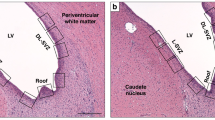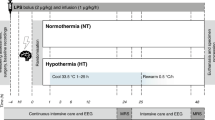Abstract
The aim of this study was to produce a neonatal piglet model which, avoiding vessel ligation, exposed the whole animal to hypoxia and produced dose-dependent clinical encephalopathy and neuropathologic damage similar to that seen after birth asphyxia. Twenty-three piglets were halothane-anesthetized. Hypoxia was induced in 19 piglets by reducing the fractional concentration of inspired oxygen (Fio2) to the maximum concentration at which the EEG amplitude was below 7 μV (low amplitude) for 17-55 min. There were transient increases in Fio2 to correct bradycardia or hypotension. Posthypoxia, the piglets were extubated when breathing was stable. Four were shamtreated controls. We aimed at 72-h survival; seven died prematurely due to posthypoxic complications. EEG and a videotaped itemized neurologic assessment were recorded regularly. We found that 95% of the animals showed neuropathologic damage. The duration of low amplitude EEG during the insult and the arterial pH at the end of the insult correlated with cortical/white matter damage; r = 0.75 and 0.81, respectively. Early postinsult EEG background amplitude (r = 0.86 at 3 h) and neurologic score (r = 0.79 at 8 h) correlated with neuropathology. Epileptic seizures in seven animals were always associated with severe neuropathologic damage. We conclude that EEG-controlled hypoxia and subsequent intensive care enabled the animals to survive with an encephalopathy which correlated with the cerebral hypoxic insult. The encephalopathy was clinically, electrophysiologically, and neuropathologically similar to that in the asphyxiated term infant. This model is suitable for examining mechanisms of damage and evaluation of potential protective therapies after birth asphyxia.
Similar content being viewed by others
Log in or create a free account to read this content
Gain free access to this article, as well as selected content from this journal and more on nature.com
or
Abbreviations
- LA:
-
low amplitude
- Fio2:
-
fraction of inspiratory oxygen
- PAco2:
-
end-tidal CO2
- PAo2:
-
end-tidal O2
- PacoO2:
-
arterial CO2
- Pao2:
-
arterial O2
- Sao2:
-
transcutaneous arterial oxygen saturation
- MABP:
-
mean arterial blood pressure
References
Nelson KB, Ellenberg JH 1986 Antecedents of cerebral palsy. Multivariate analysis of risk. N Engl J Med 315: 81–86.
Volpe JJ 1995 Hypoxic-ischemic encephalopathy: neuropathology and pathogenesis. In: Volpe JJ (ed) Neurology of the Newborn. WB Saunders, Philadelphia, pp 279–313.
Hagberg H, Gilland E, Diemer NH, Andiné P 1994 Hypoxia-ischemia in the neonatal rat brain: histopathology after post-treatment with NMDA and non-NMDA receptor antagonists. Biol Neonate 66: 205–213.
Bigge CF, Boxer PA 1994 Neuronal cell death and strategies for neuroprotection. In: Bristol JA (eds) Annual Reports in Medicinal Chemistry. Academic Press, San Diego, CA, pp 13–22.
Rootwelt T, Løberg EM, Moen A,Øyasæther S, Saugstad OD 1992 Hypoxemia and reoxygenation with 21% or 100% oxygen in newborn pigs: changes in blood pressure, base deficit, and hypoxanthine and brain morphology. Pediatr Res 32: 107–113.
Jacobson HE, Windle WF 1960 Responses of foetal and newborn monkeys to asphyxia. J Physiol 153: 447–456.
Myers RE, Kopf GS, Mirvis DM 1980 Hemodynamic response to profound hypoxia in intact rhesus monkeys. Stroke 11: 389–393.
Haaland K, Steen PA, Thoresen M 1996 Cerebral, tympanic and colon thermometry in the piglet. Reprod Fertil Dev 8: 125–128.
Wass CT, Lanier WL, Hofer RE, Scheithauer BW, Andrews AG 1995 Temperature changes of ≥1 °C alter functional neurologic outcome and histopathology in a canine model of complete cerebral ischemia. Anesthesiology 83: 325–335.
Brierley JB, Brown AW, Meldrum BS 1971 The nature and time course of the neuronal alterations resulting from oligaemia and hypoglycemia in the brain of Macaca mulatta. Brain Res 25: 483–499.
Løberg EM, Hassel B, Fonnum F, Torvik A 1994 Early entry of plasma proteins into damaged neurons in brain infarcts. APMIS 102: 771–776.
Friede RL 1991 Some features of basics reactions characteristic for immature nervous tissue. In: Friede RL (ed) Developmental Neuropathology. Springer-Verlag, Berlin, pp 21–25.
Kabat H 1940 The greater resistance of very young animals to arrest of the brain circulation. Am J Physiol 122: 588–599.
Duffy TE 1975 Carbohydrate and energy metabolism in perinatal rat brain: relation to survival in anoxia. J Neurochem 24: 271–276.
Ikonomidou C, Mosinger JL, Shahis SK, Labruyere J, Olney JW 1989 Sensitivity of the developing rat brain to hypobaric/ischemic damage parallels sensitivity to N-methyl-D-aspartate neurotoxicity. J Neurosci 9: 2809–2818.
Volpe JJ 1995 Specialized studies in the neurological evaluation. In: Volpe JJ (ed) Neurology of the Newborn. WB Saunders, Philadelphia, pp 160–171.
Sarnat HB 1992 Embryology and Clinical Expression. Oxford University Press, Oxford, pp 1–473.
Oppenheim RW 1985 Naturally occurring cell death during neural development. Trends Neurosci 8: 487–493.
Duffy TE, Nelson TR, Lowry OH 1972 Cerebral carbohydrate metabolism during acute hypoxia and recovery. J Neurochem 19: 959–977.
Chugani HT, Phelps M 1986 Maturational changes in cerebral function in infants determined by 18FDG positron emission tomography. Science 231: 840–843.
Ostwald K, Hagberg H, Andiné P, Karlsson J-O 1993 Upregulation of calpain activity in neonatal rat brain after hypoxia-ischemia. Brain Res 630: 2849–294.
Vanucci RC, Yager JY 1992 Glucose, lactic acid and perinatal hypoxic-ischemic brain damage. Pediatr Neurol 8: 3–12.
LeBlanc MH, Huang M, Vig V, Patel D, Smith EE 1993 Glucose affects the severity of hypoxic-ischemic brain injury in newborn pigs. Stroke 24: 1055–1062.
Myers RE 1976 Anoxic brain pathology and blood glucose. Neurology 26: 345–354.
McDonald JW, Johnston MV 1990 Physiological and pathological roles of excitatory amino acids during central nervous system development. Brain Res Rev 15: 41–70.
McRae A, Gilland E, Bona E, Hagberg H 1995 Microglia activation after neonatal hypoxic-ischemia. Dev Brain Res 84: 245–252.
Reynolds EOR, Wyatt JS, Azzopardi D, Delpy DT, Cady EB, Cope M, Wray S 1988 New non-invasive methods for assessing brain oxygenation and haemodynamics. Br Med Bull 44: 1052–1075.
Rice JEI, Vannucci RC, Brierley JB 1981 The influence of immaturity on hypoxic-ischemic brain damage in the rat. Ann Neurol 9: 131–141.
Myers RE 1977 Experimental models of perinatal brain damage: relevance to human pathology. In: Gluck L (ed) Intrauterine Asphyxia and the Developing Fetal Brain. Year Book, Chicago, pp 37–97.
Lorek A, Takei Y, Cady E, Wyatt J, Penrice J, Edwards A, Peebles D, Wylezinska M, Owen-Reece H, Kirkbridge V, Cooper C, Aldrige R, Roth S, Brown G, Delphy D, Reynolds EOR 1994 Delayed (“secondary”) cerebral energy failure following acute hypoxia-ischemia in the newborn piglet: continuous 48-hour studies by phosphorus magnetic resonance spectroscopy. Pediatr Res 36: 699–706.
LeBlanc MH, Farias LA, Evans OB, Vig V, Smith EE, Markov AK 1991 Fructose-1,6-bisphosphate, when given immediately before reoxygenation, or before injury, does not ameliorate hypoxic ischemic injury to the central nervous system in the newborn pig. Crit Care Med 19: 75–83.
LeBlanc MH, Vig V, Smith B, Parker CC, Evans OB, Smith EE 1991 MK-801 does not protect against hypoxic-ischemic brain injury in piglets. Stroke 22: 1270–1275.
Thoresen M, Penrice J, Lorek A, Wyatt J, Cady EB, Wylezinska M, Kirkbridge V, Cooper C, Edwards D, Brown G, Reynolds EOR 1995 Mild hypothermia following severe transient hypoxia-ischemia ameliorates delayed (“secondary”) cerebral energy failure in the newborn piglet. Pediatr Res 5: 667–670.
Laptook AR, Corbett JT, Nguyen NT, Peterson J, Nunnally RL 1988 Alterations in cerebral blood flow and phosphorylated metabolites in piglets during and after partial ischaemia. Pediatr Res 23: 206–211.
DiGiacomo JE, Pane CR, Gwiazdowski S, Mishra OP, Delivoria-Papadopoulos M 1992 Effect of graded hypoxia on brain cell membrane injury in newborn piglets. Biol Neonate 61: 25–32.
Hoffman DJ, McGowan JE, Marro PJ, Mihsra OP, Delivoria-Papadopoulos M 1994 Hypoxia-induced modification of theN- methyl-D-aspartate receptor in the brain of the newborn piglet. Neurosci Lett 167: 156–160.
Leech R, Alvord EC 1977 Anoxic-ischemic encephalopathy in the human neonatal period: The significance of brain stem involvement. Arch Neurol 34: 109–113.
Banker BQ, Larroche J-C 1962 Periventricular leukomalacia of infancy. A form of neonatal anoxic encephalopathy. Arch Neurol 7: 386–410.
Takashima S, Armstrong DL, Becker LE 1978 Subcortical leucomalacia. Relationship to development of the cerebral sulcus and its vascular supply. Arch Neurol 35: 470–472.
Azzarelli B, Meade P, Mulelr J 1980 Hypoxic lesions in areas of primary myelination Childs B. rain 7: 132–145.
Friede RL 1991 Perinatal lesions of white matter. In: Friede RL (eds) Developmental Neuropathology. Springer-Verlag, Berlin, pp 69–81.
Holm IE, West M 1994 Hippocampus of the domestic pig: a stereological study of subdivisional volumes and neuron numbers. Hippocampus 4: 115–126.
Selkoe DJ, Myers RE 1979 Neurologic and cardiovascular effects of hypotension in the monkey. Stroke 10: 147–157.
Holmes G, Rowe J, Hafford J, Schmidt R, Testa M, Zimmerman A 1982 Prognostic value of the electroencephalogram in neonatal asphyxia. Electroencephalogr Clin Neurophysiol 53: 60–72.
Hellström Westaas L, Rosén I, Svenningsen NW 1995 Predictive value of early continuous amplitude integrated EEG recordings on outcome after severe birth asphyxia in full term infants. Arch Dis Child 72:F34–F38.
Van Lieshout HBM, Jacobs JWFM, Rotteveel JJ, Geven W, Hof MV 1995 The prognostic value of the EEG in asphyxiated newborns. Acta Neurol Scand 91: 203–207.
Levene MI 1995 Management and outcome of birth ashyxia. In: Levene MI, Lilford RJ (eds) Fetal and Neonatal Neurology and Neurosurgery. Churchill Livingstone, Edinburgh, pp 427–443.
Calciolari G, Perlman JM, Volpe J 1988 Seizures in the Neonatal Unit of the 1989. Types, etiologies, timing. Clin Pediatr 27: 119–123.
Caveness W, Nielsen KC, Yakovlev PI 1962 Electroencephalographic and clinical studies of epilepsy during the maturation of the monkey. Epilepsia 3: 137 15150
Connell J, Oozeer R, de Vries L, Dubowitz LM, Dubowitz V 1989 Continuous EEG monitoring of neonatal seizures: diagnostic and prognostic considerations. Arch Dis Child 64: 452–458.
Kette F, Weil MIL, Gazmuri RJ, Bisera J, Rackow EC 1993 Intramyocardial hyperbaric acidosis during cardiac arrest and resuscitation. Crit Care Med 21: 901–906.
Vannucci RC, Towfighi J, Heitjan DF, Brucklacher RM 1995 Carbon dioxide protects the perinatal brain from hypoxic-ischemic damage: an experimental study in the immature rat. Pediatrics 95: 868–874.
Schmidt U, Schwinger RHG, Bohm M 1995 Halothane restores the altered force-frequency relationship in failing human myocardium. Anesthesiology 82: 1456–1462.
Acknowledgements
Invaluable technical advice was received from SINTEF. At the National Hospital, the technical department and the medical library have provided continuous support. We particularly thank the chief veterinarian Dag Sørensen for excellent assistance and advice.
Author information
Authors and Affiliations
Additional information
Supported by the Norwegian Research Council (M.T, K.H, F.A), the Lærdal Foundation for Acute Medicine, the Norwegian SIDS Society, and the Norwegian Council for Cardiovascular Diseases.
Rights and permissions
About this article
Cite this article
Thoresen, M., Haaland, K., Løberg, E. et al. A Piglet Survival Model of Posthypoxic Encephalopathy. Pediatr Res 40, 738–748 (1996). https://doi.org/10.1203/00006450-199611000-00014
Received:
Accepted:
Issue date:
DOI: https://doi.org/10.1203/00006450-199611000-00014
This article is cited by
-
Hydrogen gas can ameliorate seizure burden during therapeutic hypothermia in asphyxiated newborn piglets
Pediatric Research (2024)
-
Conflicting findings on the effectiveness of hydrogen therapy for ameliorating vascular leakage in a 5-day post hypoxic-ischemic survival piglet model
Scientific Reports (2023)
-
Cerebral hemodynamic response during the resuscitation period after hypoxic-ischemic insult predicts brain injury on day 5 after insult in newborn piglets
Scientific Reports (2022)
-
Short-term outcomes of remote ischemic postconditioning 1 h after perinatal hypoxia–ischemia in term piglets
Pediatric Research (2021)
-
Non-invasive diffuse optical neuromonitoring during cardiopulmonary resuscitation predicts return of spontaneous circulation
Scientific Reports (2021)



